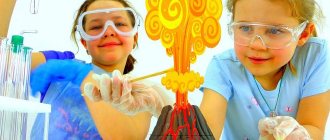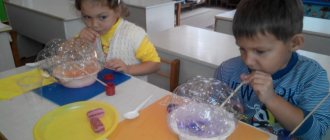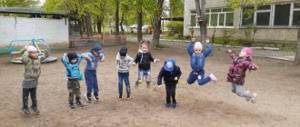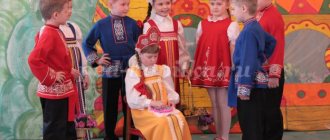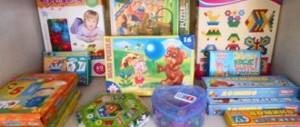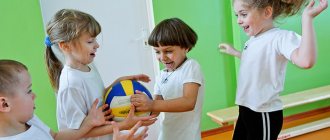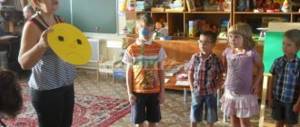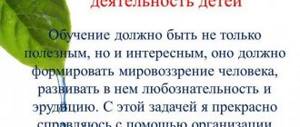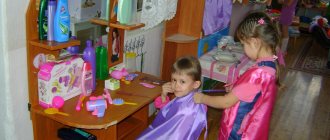Lesson on cognitive and research activities in kindergarten
Cognitive and research activity is one of the spontaneous manifestations of a child’s curiosity. This quality of an inquisitive mind must be actively involved in a variety of classes: studying the surrounding world, productive (drawing, modeling, designing), preparing for literacy, etc. Exclusively research activities occupy a small part in the educational process, sometimes they are separated into club activities (work in mini-laboratories, experimental workshops). The teacher should practice conducting integrated classes in which work is carried out in several directions (“artistic and aesthetic development”, “cognitive activity”, “labor activity”, etc.), paying maximum attention to the formation and improvement of research skills when studying by children objects and phenomena of the surrounding world.
After directly studying the vegetables, the children can draw them
Table: card index of topics for educational and research activities
| Research topic | Tasks | Age group |
| "Water and its properties" |
| Junior |
| "Magic Sponges" |
| Junior |
| "Lemon" | Formation of the ability to conduct research in various ways: visual, olfactory, kinetic. | Junior |
| “I'm a researcher. Stone" |
| Junior |
| “Why did the snowman melt?” |
| Average |
| "Milk" |
| Average |
| "Lost and found" |
| Average |
| "Amazing Ball" | Formation of ideas about the properties of rubber in the process of research activities. | Average |
| "Merry vegetable garden" | Expanding knowledge about cultivated plants and methods of growing them. | Average |
| "Energy. Current runs through the wires" |
| Older |
| "The Amazing Magnet" |
| Older |
| "Pillow" | Development of the ability to compare, generalize and draw conclusions (using the example of studying pillows with various fillings - synthetic winterizer, cotton wool, fluff, buckwheat husk, straw). | Older |
| "Volcano" | Improving the ability to work with various materials and substances during the experiment. | Older |
| "Worms" |
| Older |
| "Salt" | Formation of ideas about the properties of salt (including salt water) and their use in production and everyday life. | Preparatory |
| "Thermometer" |
| Preparatory |
| "The Diver from Komarovo" | Formation of ideas about the floating of bodies, air pressure and liquids. | Preparatory |
| "Human Pupil" | Acquaintance with the properties of the pupil to expand and contract depending on lighting. | Preparatory |
Table: lesson notes on cognitive and research activities in the senior group (fragment)
| Author | Zakharova E., teacher of MBDOU D/s No. 8 “Cheburashka”, Belaya Kalitva, Rostov region. |
| Subject | "Volcano" |
| Target | Introduce children to a natural phenomenon - a volcano. |
| Tasks |
|
| Materials |
|
| Progress of the lesson | Motivation. V.: Guys, today the postman brought us a parcel. Are you interested in knowing what's in it? (They open it, there is pumice there). Who knows what this is? What is the name of? What is it for? Maybe someone has such an item at home? (Children's answers). Preschoolers examine pumice and compare it with the rocks already available in the experimentation corner: coal, chalk, sandstone. V.: There is also a note in the parcel, and there is a hint in it, listen:
But this object does not look like a volcano at all. This hint did not help us, but, on the contrary, confused us. Guys, are you interested in knowing what this item is? Then we will try to find out. We will also find out what a volcano is and how it is connected to the mystery object. The teacher tells the children a legend about the volcano. <…> V.: Now do you want to see what a real volcano looks like? (Children's answers). Our computer will help us. (Show slides with different types of volcanoes: “sleeping”, “waking up”, “boiling”, erupting). Volcanoes erupt in different ways. Sometimes they seem to explode, throwing magma up and to the sides. A huge mountain shakes with a terrible roar, a huge cloud of smoke and ash rises above it, and stone rain showers the slopes. And sometimes it flows out “calmly.” What does a volcano look like? (A volcano is a large mountain with steep sides). What shape is the volcano? (Cone). At the very top of the volcano there is a crater. The crater is a huge bowl with steep slopes, and at the bottom there is a reddish-orange mouth, this is the mouth of a volcano, a hole going deep into the ground. The fiery liquid coming out of a volcano is called lava. Interesting? Do you want to see a volcanic eruption? I suggest you do an experiment: a volcanic eruption. Where can you do experiments? (In the laboratory). I suggest you go to our laboratory of “interesting discoveries” (they go to tables with volcano models prepared in advance and all the necessary components for the experiment). In our laboratory, everything is ready to conduct experiments. What will we make the base of the volcano from? (From the cone). What is a volcano's mouth made of? (A plastic cup). All this is on a tray. Before you begin the experiment, you need to study the diagram. (The teacher, together with the children, discusses the sequence of the experiment.)
What are you observing? Watch your volcano erupt. It erupts calmly. <…> Guys, can we show a volcanic eruption? Shall we try? Sketch “The volcano wakes up and erupts.” V.: Guys, you and I did the “Volcanic Eruption” experiment, and I told you the legend about the volcano, and we learned the structure of the volcano, and even depicted the volcano ourselves... But they forgot a little about our mysterious object, what it is after all ? Maybe someone figured it out after all? (Children's answers). And if we don’t know something, who or where can we find out? (Encyclopedia, reference book, on the Internet). Do we have an encyclopedia in the library? Let's see if there is an answer to our question. We open it and read: this is pumice - frozen volcanic lava. Used to remove dirt from hands or rough skin from heels. Questions for reflection:
V.: I’m glad that you really liked it, and you were so attentive, active, inquisitive, great fellows! |
| Quote from: https://www.maam.ru/detskijsad/konspekt-zanjatija-poznavatelno-isledovatelskaja-dejatelnost-vulkan-starshaja-grupa.html | |
Lesson time plan
The duration of educational classes in kindergarten depends on the age of the students and is determined by SanPiN standards:
- junior group - 15 minutes;
- middle group - 20 minutes;
- senior group - 25 minutes;
- preparatory group - 30 minutes.
In the middle of the lesson, physical education or an active game should be carried out as a means of preventing overwork.
Since cognitive-research activities require mental effort, they should be conducted in the first half of the day, preferably on Tuesday or Wednesday - days of high performance.
Table: time plan for the lesson “Visiting the Paper Fairy” in the younger group
| Structural component of the lesson | Motivating start (surprise moment) | Didactic game | Physical education minute | Study of paper properties | Summarizing |
| Time spending | 2 minutes | 2–3 minutes | 1–2 minutes | 7 minutes | 1–2 minutes |
Table: time plan for the lesson “Journey to the World of Water” in the middle group
| Structural component of the lesson | Motivating start (creating a game situation, solving riddles) | Didactic game | Outdoor game | Studying the properties of water (conducting experiments) | Summarizing |
| Time spending | 2–3 minutes | 3 minutes | 3 minutes | 10 minutes | 1–2 minutes |
Table: time plan for a lesson during a walk “Why do icicles cry?” in the senior group
| Structural component of the lesson | Motivating beginning (reading and discussion of a didactic fairy tale) | Charging outdoors | Research (observation of icicles in the shade and in the sun) | Work assignments | Conducting an experiment with ice floes | Summarizing |
| Time spending | 3–4 minutes | 5 minutes | 10 minutes | 5–7 minutes | 4 minutes | 2 minutes |
Table: time plan for the lesson “What is a rainbow?” in the preparatory group
| Structural component of the lesson | Motivating beginning (surprise moment, problematic situation, watching a video) | Heuristic conversation | Outdoor game | Didactic game | Studying the conditions for the appearance of a rainbow (conducting an experiment) | Summarizing |
| Time spending | 3 minutes | 3–5 minutes | 3–4 minutes | 3 minutes | 12–14 minutes | 1–2 minutes |
COGNITIVE AND PRACTICAL ACTIVITIES
⇐ PreviousPage 27 of 72Next ⇒AS A MEANS OF MENTAL DEVELOPMENT OF YOUNG CHILDREN
PRESCHOOL AGE
Lyatetskaya I.N. , master's student
(Brest, EE "BrSU named after A.S. Pushkin")
Scientific supervisor – Kazaruchik G.N., Candidate of Pedagogical Sciences, Associate Professor
Currently, the urgent problem is to find effective means that would promote the mental development of children of primary preschool age and would take into account the age and individual characteristics of the child. Thus, the problem of using didactic games as a means of mental development was dealt with by V.N. Avanesova, Z.M. Boguslavskaya, R.I. Zhukovskaya, E.I. Tikheyeva, A.P. Usova. Works by E.V. Zaiki, N.Yu. Shlat showed the effectiveness of using logical (intellectual) games for the mental development of preschool children. L.R. Anosova, L.S. Vakulenko, N. Gavrish explored the possibilities of artistic expression for the mental development of children. E.A. Smoler theoretically substantiated and practically proved the importance of heuristic activity in the formation of the intellectual activity of preschoolers. In the works of N.A. Baranova, M.P. Goloshchekina, G.V. Kosobutskaya, I.V. Starodubtseva means physical exercises for the mental development of preschool children. Issues of using cognitive and practical activities in the development of preschool children were dealt with by I.I. Bychkova, A.V. Korzun, G.A. Kudryavtseva, E.I. Smoler. However, the problem of cognitive-practical activity as a means of mental development of children of primary preschool age has not been sufficiently studied and requires consideration. Based on this, in our research we set a goal: to develop methodological support for the process of mental development of children of primary preschool age in cognitive and practical activities.
Taking into account the importance of mental development in the development of a child’s personality, as well as the great potential of cognitive and practical activity, a methodology was developed and a pedagogical experiment was conducted, including three stages: ascertaining, transformative and control.
The purpose of the ascertaining stage was to determine the level of mental development of children of primary preschool age at the beginning of the experiment. As a result of the ascertaining stage of the experiment, children of the experimental and control groups (EG and CG) demonstrated the following level of mental development: a) experimental: high level - 0%, average - 38%, low - 62%; b) control group: high level – 2%, medium – 37%, low – 61%. There were no statistically significant differences according to the χ2 criterion between preschoolers of both groups (see table).
Table - Level of mental development of the EG and CG on the ascertaining
stage of the experiment
| State of the art | Experimental group | Control group | Statistical significance of differences between EG and CG |
| absolute number | % | absolute number | % |
| High | χ2 = 0.997 | ||
| Average | |||
| Short |
Based on the analysis of the results of the ascertaining stage of the experiment, a transformative stage was developed and carried out, during which the methodology of mental development of children of primary preschool age was tested in the process of organizing cognitive and practical activities. When organizing cognitive and practical activities in the process of mental development of preschool children, we adhered to the following provisions:
– younger preschoolers have an inherent need for cognition, which manifests itself in curiosity and an active position in relation to the surrounding reality;
– cognitive and practical activities develop all mental processes in a fun way: sensation, perception, thinking, memory, imagination, attention, as well as various ways of cognition;
– cognitive and practical activity is emotionally charged, which effectively affects the process of cognition and stimulates the development of curiosity;
– cognitive-practical activity helps the child get rid of uncertainty and fear of making a mistake, which allows efforts to be directed towards cognitive activity.
In the process of cognitive and practical activity, the following conditions were observed. We indirectly controlled the child’s activities, excluding direct influence and providing the opportunity for full self-organization and self-development. In the process of organizing cognitive and practical activities, we focused on the zone of proximal development, where learning was ahead of development, stimulating the child’s activity. Younger preschoolers were offered tasks of different types, levels of complexity and their variable use, which made it possible to diversify the process of interaction with children and develop mental processes and ways of cognition. During the transformative stage of the experiment, individual and differentiated approaches were implemented to take into account the individual characteristics of preschool children and the level of mental development of children. The process of interaction with the child was emotionally rich, which allowed younger preschoolers not only to satisfy the hedonic function of the work done, but also to realize the creative potential of the individual. A developing subject-spatial and landscape environment was created. It included various attributes, schemes, models for organizing cognitive and practical activities, which contributed to the development of cognitive activity and provided an opportunity to examine in detail the objects and phenomena being studied.
The developed methodology involves interaction between the teacher and the child individually or in microgroups outside of class. The methodology provides a solution to the main objectives of the Praleska preschool education program, and its content also has a number of additional information available for development by children of primary preschool age, which allows them to create a holistic understanding of the subjects and phenomena under consideration. The thematic content of cognitive and practical activities changed monthly and had a semantic correspondence with the topics of the classes.
The developed methodology included tasks of different types: survey, creative and organizational. Survey tasks involved studying an object according to a specific algorithm. They allowed younger preschoolers, by interacting with objects, to learn their new properties and qualities. Thus, by organizing the study of snow, the children became acquainted not only with the external features of snow, but with the ability of snow at high temperatures to turn into a liquid state, become colored, etc. Creative tasks were aimed at providing the child with the opportunity to show creativity. For example, during an introduction to different types of paper, children were asked to create a drawing of their choice on suitable paper (tinted, colored, “sprayed”, etc.). Organizational tasks allowed younger preschoolers to master the basics of monitoring their own activities and the activities of other children. Making mistakes that affected the results of cognitive and practical activities, children analyzed their actions and predicted the course of actions. The use of various types of tasks made it possible to develop all mental processes (sensation and perception, memory, thinking, imagination, attention) and ways of cognition.
The methodology contained tasks of different difficulty levels. The reconstructive level of complexity included children's activities in a partially modified situation with which preschoolers are familiar. For example, after becoming familiar with the properties of snow, younger preschoolers were asked to independently determine and check where the snow would melt faster: on the windowsill, on the radiator, on a shelf in the group room. The logical level of complexity required logical processing of acquired knowledge. This level was typical for a task during which younger preschoolers became familiar with the process of baking bread. The use of different levels of complexity made it possible to diversify the process of organizing cognitive and practical activities and to intensify the development of thought processes and ways of knowing.
During the transformative stage of the experiment, the emotional state of the children was taken into account: if the child did not want to study or felt unwell, the experimenter postponed the time of interaction with the preschooler to another day. The children enjoyed participating in educational and practical activities. Initially, the experimenter took the leading role. Then, as the children became more active and became increasingly interested in the activities, adult participation was reduced to a minimum.
Cognitive and practical activities enriched and activated the children’s vocabulary. In their speech, they began to use various words and phrases that they had not used before: “cotton”, “linen fabric”, “silicon”, “marble”, “balsam”, etc. Children began to better analyze problem situations and argue conclusions. When solving problem situations, each junior preschooler wanted to express his assumption, citing what he thought was reasoned evidence.
To identify the effectiveness of the method of mental development of younger preschoolers developed and tested at the transformative stage of the experiment in the process of cognitive and practical activity, a control stage was conducted. At this stage of the study, we set the following tasks:
1) identify the dynamics of mental development of children of primary preschool age;
2) to trace the influence of cognitive and practical activities on the mental development of younger preschoolers.
The diagnostic results showed that the level of mental development of children from the EG became much higher, not only compared to the beginning of the experiment, but also compared to younger preschoolers from the CG (see figure). Analysis of the results reveals statistically significant differences according to the χ2 criterion in the level of mental development between children from the EG and CG in all selected parameters (ways of cognition, sensations, perception, thinking, imagination, memory, attention).
Thus, analyzing the results of the experiment, it can be argued that cognitive and practical activity contributes to the mental development of children of primary preschool age. This activity promotes the development of the preschooler’s sensations and perceptions and promotes the assimilation of basic sensory standards. The thinking of a younger preschooler becomes visual and figurative. In the process of cognitive and practical activity, the volume of memory expands, voluntary attention is formed, and methods of cognition are developed that make it possible to qualitatively improve the process of cognition of the surrounding reality by children of primary preschool age.
Figure – Level of mental development of children from the EG and CG at the control test
stage of the experiment
Based on the results of pedagogical research, we can assert that cognitive and practical activity contributes to the mental development of children of primary preschool age, subject to the following conditions. Firstly, with indirect control by the teacher of the child’s activities, excluding direct influence and providing the opportunity for full self-organization and self-development. Secondly, when the teacher is oriented towards the zone of proximal development, which ensures interaction in such a way that learning is ahead of development, stimulating the child’s activity. Thirdly, when selecting tasks of different types and levels of complexity, taking into account the tasks of mental development of younger preschoolers and their variable use. Fourthly, when implementing an individual and differentiated approach during the organization of cognitive and practical activities, which consists of taking into account the individual characteristics of preschool children and the level of mental development of children. Fifthly, when giving the process of cognition an emotionally rich character. Sixthly, when creating a developing subject-spatial and landscape environment, which includes various attributes, patterns, models for organizing cognitive and practical activities and providing the necessary conditions for the mental development of younger preschoolers.
⇐ Previous27Next ⇒
The use of visual material when organizing experimental activities in preschool educational institutions
Within the framework of the designated topic, we are not talking about visual materials traditionally used in classes - posters, illustrations, cards with diagrams. Research activities are accompanied by a mandatory stage of work - documenting the information received. The teacher should draw the children's attention to the fact that scientists (researchers and inventors) write down their observations and conclusions that they come to in the process of studying any phenomena or properties of objects.
To record observations of preschoolers, the following forms can be used:
- Research cards. The children fill out special forms, which are then compiled into a file cabinet of observations and experiments.
- Personal diary of observations. This form offers more room for creativity and expression of individuality than cards. Children can be allowed to make notes, sketches, and diagrams in their diary.
- Stands. You can record children's experimentation by designing stands: hanging a plan for conducting experiments, diagrams and photographs with the results.
- Lapbooks are hand-made folding books on the topic of research carried out (“Water”, “Weather”, “Insects”, “Properties of Air”, etc.). Templates can be used to create such books. It will be great if parents help the children in designing lapbooks.
A laptop is a thematic folder containing a number of pockets, windows, and miniature nested books. It can accommodate a huge amount of material on the topic, presented in the form of cards, illustrations, diagrams, educational games, etc.
Photo gallery: visual materials for recording research activities in kindergarten
Research cards display observation results
The observation log displays the results of daily research
You can make a nature diary yourself or purchase it in a store.
Older preschoolers can keep individual observation diaries
The results of experiments can be recorded in special notebooks
The finished laptop can be studied for a long time and with interest.
Making a lapbook helps children explore an object comprehensively
Video: what is a lapbook
Organization of search activities of preschool children
Bibliographic description:
Minullina, R. F. Organization of search activities of preschool children / R. F. Minullina, R. V. Ryzhmanova. — Text: direct // Education and upbringing. — 2020. — No. 1 (27). - pp. 11-12. — URL: https://moluch.ru/th/4/archive/154/4848/ (access date: 10.10.2020).
This article reveals the content and methodology for organizing the search activities of older preschoolers in the light of the federal state educational standard for preschool education.
Key words: federal state educational standard, Federal State Educational Standard, preschool education, activity, problem situation, cognitive task.
In accordance with the requirements of the Federal State Educational Standard of Preschool Education for the results of mastering the basic educational program, presented in the form of targets, at the stage of completion of preschool education, “the child shows curiosity, asks questions to adults and peers, is interested in cause-and-effect relationships, and tries to independently come up with explanations for phenomena nature and actions of people; inclined to observe and experiment.”
The scientific search for effective means of achieving the designated guidelines represents an urgent problem that requires theoretical and practical solutions. Among the possible means of developing the cognitive activity of preschoolers, search activity deserves special attention.
Elementary search activity is the joint work of the teacher and children, aimed at solving cognitive problems that arise in educational activities, in everyday life, in play and work, in the process of learning about the world.
The emergence and development of almost limitless search and research activities aimed at understanding the world around us is based on the child’s need for new impressions, given by nature itself. The more varied and intense the search activity, the more new information the child receives, the faster and more fully he develops.
Search activities are carried out in a specific system. It begins with the teacher setting and children accepting a cognitive task; it is also possible for children to set a cognitive task. Then its primary analysis is carried out and assumptions are made, methods for testing the assumptions put forward by children are selected, and they are verified. The search activity ends with an analysis of the results obtained during the inspection and the formulation of conclusions.
Elementary search activity as a form of organization is used in older preschool age. In accordance with the educational program, the teacher develops a system of cognitive tasks that he gradually sets for the children. For this, it is important to create problem situations in classes or in various activities, in everyday life, in play, work, and in the process of learning about the world.
A problematic situation arises when a problem already exists, but its solution is not immediately available to children. An effort of thought is required to compare already known facts and draw some conclusions. Children’s independent work in such a situation is exploratory in nature.
After the children accept the cognitive task, under the guidance of the teacher, it is analyzed, the known and the unknown are identified. As a result of such an analysis, under the guidance of the teacher, assumptions are made about the possible causes of the observed phenomena.
The assumptions made by children may be correct, incorrect, or even contradictory. But at the same time, they all need to be discussed. It is important to listen to all the children’s assumptions and pay attention to their inconsistencies. offer to check whose is more correct. If the children do not make assumptions, the teacher encourages them to do so or makes the necessary assumptions himself.
During the analysis and evaluation of assumptions, children develop interest and it should be used to move to the next stage of search activity - consideration of verification options and the verification itself.
Children usually offer different methods of verification, and the teacher can also offer them: short-term recognition observations, long-term comparative observations, elementary experiments, demonstration of models, heuristic conversations, etc.
Formulation of conclusions is the final stage of search activity. It is necessary to encourage children to formulate conclusions on their own, take the time to give them hints, listen to all the children’s statements, and ask questions to guide their thoughts in the right direction. If children's conclusions are incorrect, additional experiments or observations can be organized so that everyone comes to the correct conclusions.
We conducted an experimental study of the level of development of search activity by determining the cognitive activity of children of senior preschool age. For this purpose, the method of V. S. Yurkevich “Tree of Wishes” and the standardized questionnaire “Curious, active” by V. S. Yurkevich, Yu. A. Baranova were used.
During the diagnostics, it was revealed that the level of development of cognitive activity in children mainly corresponds to the average and low level. To increase the level of search activity of preschoolers, it is necessary to develop a number of measures that will contribute to the development of children’s cognitive activity and maintaining interest in search activities.
It is recommended to arrange and equip the following in the group:
– (card file of classes on research teaching methods, reading fiction: “The Great Encyclopedia for Preschoolers”, the encyclopedia “Everything about Everything”, etc.).
– Club of experts “I explore the world” (summarizing experience on topics being developed, preparing reports, monitoring, presentations of scientific works).
– Game center (verbal games, educational games and exercises).
– Mini (experimental corner).
Thus, in the process of organizing search activities, children acquire the ability to independently set cognitive tasks that reflect a deeper penetration into the essence of phenomena, the establishment of analogies, and an understanding of increasingly general patterns.
Literature:
- AbdrakhmanovaA. I. Current state of the problem of the formation of cognitive activity in children of senior preschool age. // Bulletin of Tomsk State Pedagogical University. - 2015. - No. 3. - P. 38–41.
- Ismatullaeva M. G. Formation of cognitive and personal activity in preschool children. URL.https://cyberleninka.ru (date of access: 01/09/2020).
- Shchetinina V.V. Formation of cognitive activity of children of senior preschool age in the process of search activity. M.: 2006.-126s.
- Yurkevich V.S. Development of initial levels of cognitive needs among schoolchildren // Questions of psychology. — 1980. — No. 2. — P. 83–92
Key terms
(automatically generated)
: search activity, preschool education, cognitive task, child, Federal State Educational Standard, everyday life, cognitive activity of children, problem situation, senior preschool age, elementary search activity.
Analysis and diagnosis of cognitive and research activities
To evaluate the results and effectiveness of students’ cognitive and research activities, the teacher conducts diagnostics according to the following criteria:
- ability to formulate problems by students;
- correct formulation of questions;
- building an algorithm of actions to solve the problem;
- putting forward hypotheses;
- choice of research methods;
- ability to describe observations during the research process;
- presence of thinking skills (analysis, comparison, generalization, systematization);
- degree of independence at each stage of the research;
- ability to make inferences, conclusions, summing up.
A high level of cognitive and research activity is evidenced by the presence of stable motivation to solve problem situations and search for answers to posed questions, independent construction of a research algorithm and carrying out practical work (experiments), competent formulation of the information obtained, and correct drawing of conclusions. A child with a developed research type of thinking takes the initiative in choosing materials and tools for conducting observations, is not afraid to put forward hypotheses and test them experimentally, and brings what he starts to the end in order to obtain compliance with the voiced hypothesis or refute it.
Future researchers are not afraid to put forward hypotheses and test them experimentally
To identify the attitude of pupils towards experimental activities and determine the level of mastery of research skills, the teacher can invite children to keep a special journal in which preschoolers record the results of the work done. At the same time, it is recommended that the teacher keep diagnostic cards for each student, in which he enters data from his own observations of the children’s research activity.
Development of cognitive activity as a topic for self-education of kindergarten teachers
The teacher’s self-education work consists of two stages:
- Theoretical stage of self-education. First of all, it is necessary to study regulatory documents and scientific and methodological literature, which talk about the importance and methods of organizing the cognitive and research activities of preschoolers (Federal State Educational Standard and the educational programs developed within its framework). It is also important to study the practical experience of colleagues on the topic of interest: pedagogical journals and information portals on preschool pedagogy widely present materials on organizing experimental activities for children (carrying out projects in preschool settings, notes on individual classes and research-oriented outings). The theoretical stage also includes the development of thematic planning: setting general goals and objectives of the proposed course of study with a table of specific activities for each age group of students.
- The practical stage is the implementation of the prepared base into practice. The teacher organizes classes on research activities in accordance with the curriculum in the first half of the day or opens a circle for additional education. During the school year, the teacher holds thematic meetings or consultations for parents, in which he introduces them to the tasks of the experimental activity and shows the results achieved by the children. The teacher should strive to involve preschoolers in project activities and participation in city and regional competitions. The teacher reports on the effectiveness of his work at teacher councils, seminars and thematic round tables.
In the process of research work, children’s natural need for experimentation and curiosity is satisfied. Carrying out observations and participating in experiments brings joy and delight to the little researcher. At the same time, during these classes an important information base is laid about the properties of objects and substances and the thinking abilities necessary for success in the future are developed.
Development of a preschooler in cognitive and research activities in the context of the implementation of the Federal State Educational Standard for Education
In accordance with the introduction of the Federal State Educational Standard for preschool education and with the requirements for the results of mastering the basis of the educational program, presented in the form of targets at the stage of completing the level of preschool education: one of the guidelines is curiosity. The child asks questions regarding near and distant objects and phenomena, is interested in cause-and-effect relationships (how? why? why?), tries to independently come up with explanations for natural phenomena and people’s actions, and is inclined to observe and experiment.
Federal State Educational Standards for Educational Education direct the content of the educational field “Cognition” to achieve the goals of developing children’s cognitive interests, intellectual development of children through problem solving: development of cognitive, research and productive activities; formation of a holistic picture of the world, broadening the horizons of children.
Children are natural explorers of the world around them. The world opens up to the child through the experience of his personal feelings, actions, and experiences. “The more a child has seen, heard and experienced, the more he knows and has assimilated, the more elements of reality he has in his experience, the more significant and productive, other things being equal, his creative and research activity will be,” wrote the classic of Russian psychological science. science Lev Semyonovich Vygodsky. [2,p.3]
Therefore, I believe that the development of the cognitive interests of preschool children is one of the pressing problems designed to educate an individual capable of self-development and self-improvement.
The increasing attention of modern educational psychology and educational practice to the issues of research behavior and research learning is due to the main feature of the modern world - its high dynamism. The changes taking place around us are so intense and so rapid that a person is less and less able to maintain harmony with his surroundings, using old habitual behavioral patterns. Everyday life constantly requires each of us to display search activity. This is also important because the most valuable and lasting knowledge is obtained independently, in the course of one’s own creative research. On the contrary, knowledge acquired through learning is usually significantly inferior in depth and strength. It is equally important that it is more natural and therefore much easier for a child to comprehend new things, acting like a scientist (conducting his own research - observing, conducting experiments, making his own judgments and conclusions based on them) than to receive knowledge already obtained by someone else in “ finished form."
When we teach children specific skills, we often deny them the chance to make their own discoveries. The famous Swiss psychologist J. Piaget argued that the desire for contact and interaction with the outside world, the desire to find and solve new problems is one of the most important properties of human nature. If the need for research remains unsatisfied, this can lead to severe disorders of the nervous system and even nervous diseases.
However, society, teachers, and parents consider themselves to have the right to limit the child’s research activities. These are numerous prohibitions: “don’t meddle,” “don’t touch,” “don’t do,” inattention to children’s issues and the firm conviction that it is too early for a child to know this and that... [3, p.5].
In modern educational practice, the importance of a child’s research and cognitive activity is clearly underestimated. We are in a hurry to teach the child what we ourselves consider important, but he himself would like to explore everything. Any child is involved in research almost constantly. This is his normal, natural state: tearing paper and seeing what happened, watching a tit on a walk, taking toys apart and studying their structure. Without noticing this, we interrupt his research impulses, trying to direct his cognitive activity in the direction that we ourselves consider necessary. As a result, educational activity becomes extremely autonomous from cognitive activity and becomes boring. Fully striving to do a good deed - to teach, we, not paying attention to the child’s natural research need, actually ourselves hinder the development of children’s curiosity [4, p.8].
But rapidly changing life forces us to reconsider the role and significance of exploratory behavior in human life. In the 21st century, it is becoming increasingly clear that research skills are required not only by those whose lives are (or will be) connected with scientific work; it is necessary for every person.
Didactic foundations of modern research teaching.
Preschoolers are natural explorers. And this is confirmed by their curiosity, constant desire to experiment, desire to independently find a solution to a problem situation. The teacher’s task is not to suppress this activity, but, on the contrary, to actively help. the main goal of my research: to create conditions for the formation of the foundations of a holistic worldview of a child of senior preschool age through experimental activities.
So, cognitive-research activity is a child’s activity aimed at understanding the structure of things, the connections between the phenomena of the surrounding world, their ordering and systematization. This activity originates in early childhood, at first representing a simple, seemingly aimless (processual) experimentation with things, during which perception is differentiated, the simplest categorization of objects by color, shape, purpose arises, sensory standards and simple instrumental actions are mastered. By the senior preschool age, cognitive-research activity is isolated into a special activity of the child with its own cognitive motives, a conscious intention to understand how things work, learn new things about the world, and streamline one’s ideas about any area of life. [6, p.7] In modern technologies by N. A. Ryzhova, A. I. Savenkova, A. I. Ivanova, this activity is organized in older preschool age in the form of experimentation or verbal research.
Structure of research activities
The following are identified as the main developmental functions of cognitive and research activity at the stage of senior preschool age:
– development of the child’s cognitive initiative (curiosity);
– the child’s mastery of fundamental cultural forms of ordering experience: cause-and-effect, genus-species (classification), spatial and temporal relations;
– the child’s mastery of fundamental cultural forms of ordering experience (schematization, symbolization of connections and relationships between objects and phenomena of the surrounding world);
– development of perception, thinking, speech (verbal analysis-reasoning) in the process of active actions to search for connections between things and phenomena;
– expanding children’s horizons by taking them beyond immediate practical experience into a broader spatial and temporal perspective (mastering ideas about the natural and social world, elementary geographical and historical ideas) [5, p.17].
Indicators of the development of research activities:
Criteria for the formation of research activities:
Types of studies:
- Experimentation with objects and their properties,
- Collecting (classification work)
- Traveling on a map (spatial relationships)
- Traveling along the “river of time” (temporary relationships).
Development of cognitive activity in the educational process of preschool educational institutions in the light of the requirements of the Federal State Educational Standard for Preschool Education.
The relevance of the problem of improving the quality of preschool education at the present stage is confirmed by the state’s interest in the issues of education and development of preschool children.
An example is the adoption of the Federal State Educational Standard for Preschool Education (FSES DO). The Federal State Educational Standard for Preschool Education considers the formation of a child’s cognitive interests and cognitive actions in various types of activities as the main principle of preschool education. In addition, the standard is aimed at developing the intellectual qualities of preschoolers. According to it, the program should ensure the development of the personality of preschool children in various types of activities.
The main forms of development of cognitive and research activities in the light of the requirements of the Federal State Educational Standard for Education: observation, excursions, solving problem situations, experimentation, collecting, modeling, project implementation, games with rules
The cognitive development of preschool children, according to the Federal State Educational Standard for Education, involves the development of children's interests, curiosity and cognitive motivation; the formation of cognitive actions, primary ideas about objects in the surrounding world, about the properties and relationships of objects in the surrounding world, etc. This content is implemented in various types of activities inherent in preschool age. One of them is cognitive-research activity - studying objects of the surrounding world and experimenting with them.
It should be noted that the Federal State Educational Standard for Educational Education focuses on the specific content of educational areas for implementation in certain types of activities, paying special attention to cognitive and research (studying objects of the surrounding world and experimenting with them). Typical activities for the implementation of this area of work are:
– organization of solving cognitive problems;
– the use of experimentation in working with children;
– use of design.
A relevant method of cognitive development of preschool children is experimentation, which is considered as a practical activity of a search nature, aimed at learning the properties, qualities of objects and materials, connections and dependencies of phenomena. In experimentation, the preschooler acts as a researcher who independently and actively explores the world around him, using various forms of influence on it.
Methods and techniques for enhancing educational and research activities of preschool children.
The content of experimental activities is built from four blocks of the pedagogical process.
- Directly organized activities with children (planned experiments).
- Joint activities with children (observations, work, artistic creativity).
- Independent activity of children (work in the laboratory).
- Joint work with parents (participation in various research projects).
Factors that develop exploratory behavior: exploration games, toys, visual arts, construction, communication, nature study.
It is no coincidence that it is believed that experimentation claims to be the leading activity in the period of preschool childhood, the basis of which is cognitive orientation. The child’s need for new impressions underlies the emergence and development of inexhaustible research activities aimed at understanding the world around him.
Experimentation is an activity that allows a child to model in his mind a picture of the world based on his own observations, answers, establishing interdependencies, patterns, etc. [7, p. 8].
To achieve these goals, I have developed an additional educational program “Eureka” for children of senior preschool age, which is compiled in accordance with the Law of the Russian Federation “On Education”; The main general educational program of preschool education is MBDOU d/s No. 95 “Rostochek” in the city of Volzhsky, Volgograd region. The program is designed for two years of implementation. (37 periods of direct educational activity per year (1 time per week), the duration of one period for children 5–6 years old is 25 minutes, for children 6–7 years old — 30 minutes).
The novelty of the program lies in:
– gradual development of the mental abilities of older preschoolers by equipping them with the skills of experimental actions and teaching them methods of independently acquiring knowledge;
– creation of a specially organized subject-development environment;
– building such a system of relationships in the child-adult coordinate, which contributes to the development of the child as a subject of cognition.
Main areas of work and methods of their implementation
| № | Main areas of work | Ways to implement them |
| 11. | Creating a subject-development environment | Creation of experimentation zones, experimental and search work. Creation of a library of educational literature for children and adults. |
| 22. | Formation of experimental activity skills in older preschoolers | Teaching older preschoolers methods and techniques of experimental activities. |
| 33. | Interaction with family | Familiarization of parents with the directions of pedagogical search in the development of experimental activities using various forms. |
| 44. | Assessing the level of mastery of experimental skills | Development of criteria for tracking work on developing skills in experimental activities. |
Analysis of psychological and pedagogical literature allows us to determine the main stages of work .
First stage.
The following tasks are solved:
– children learn to look carefully at the object being studied, describe its external signs, highlight the main thing, compare with other objects, analyze, draw conclusions and generalizations;
– are involved in solving cognitive problems and problems of direct active observation not only of static objects, but also of the development of living objects of nature;
– the teacher awakens the need to ask questions during the observation process.
Observation is one of the main methods of scientific knowledge; we began this work with the organization of perception. The teacher’s task is to develop children’s senses, expand the range of sensory ideas, and cultivate voluntary attention and all types of memory. The development of observation as a personality trait is an indicator of a child’s mental and creative development.
Second phase.
The teacher introduces children to research activities: forms research activity in the form of the ability to pose questions and resolve emerging problems. In the process of this work, children become familiar with the further stages of the study. We see our task in creating conditions for learning that should contribute to the development of the ability to ask research questions. Where do we start? We organize a series of educational games: “Riddle”, “Question”, “Guessing”, they teach you to identify the main features of an object, its functions, develop the ability to give a full description of an object, determine its place in this world, develop the ability to pose questions in order to guess item. It is clear how high the effectiveness of such work is, because play is the leading activity of children of this age. It is more difficult for children to work with “closed” and “open” questions - we use it when studying educational and literary texts.
One of the main situations in which a child must be placed in order to develop his ability to pose research questions is a problematic one. Experience shows that the process proceeds most effectively in cases where the child explores just such a situation. At this stage, it is very important to teach how to put forward evidence. In order for learning to stimulate a child’s creative development, it is important to puzzle him and include him in search activities. Therefore, the teacher says: to answer these questions, it is necessary to find additional information in the scientific literature about how these animals feed. Together with their parents, children collect information on the issue.
Third stage.
Its goal is to organize children’s own activities in the process of learning to design. The main goal is to increase the child’s share of independence in solving cognitive problems posed by both the teacher and the children themselves. Our task is to help children conduct research and make it useful. But you can’t do it without the help of your parents. The main tasks in interaction with parents are:
- establishing partnerships with the family of each pupil and joining efforts for the development and upbringing of children;
- creating an atmosphere of community of interests;
- activation and enrichment of parents' educational skills.
Childhood years are the most important and how they will pass depends on both parents and teachers.
As a result of the work done, the following indicators of children's activity have significantly improved:
- Use by older preschoolers of learned methods of experimental actions in various types of activities.
- Changing the quality of mental activity of children of senior preschool age (the ability to see a problem, the practical implementation of activity, independence and versatility in solving it).
- Increasing the level of cognitive abilities of children.
- Improving the quality of children's preparedness for school.
I can conclude that the advantage of cognitive-research activity is that it gives children real ideas about the various aspects of the object being studied, about its relationships with other objects and with the environment. The need to give an account of what was seen, to formulate discovered patterns and conclusions stimulates the development of speech, thinking, and attention of children. The consequence is not only their familiarization with new facts, but also the accumulation of a fund of mental techniques and operations that are considered as mental skills. It is impossible not to note the positive impact of experiments on the emotional sphere of children and on the development of creative abilities.
Taking into account the above, we can conclude that at the present stage of development of preschool education, much attention is paid to the problem of cognitive development of preschoolers, which in turn requires a special attitude on the part of the teacher to this problem. Thus, using experimentation, cognitive tasks and project activities when solving the problem of cognitive development of preschool children, the teacher ensures a staged transition, qualitative changes in the development of cognitive activity of preschool children.
Literature:
- Law on Education of December 29, 2012 No. 273-FZ “On Education in the Russian Federation.”
- Ivanova A.I. Natural scientific observations and experiments in kindergarten (people). - M.: Sfera, 2005.
- Ivanova A.I. Methodology for organizing environmental observations and experiments in kindergarten. Benefit for preschool employees. - M.: TC Sfera, 2003.
- Organization of experimental activities for preschool children. Ed. Prokhorova L.N. - M.: ARKTI, 2004.
- Poddyakov N. N. Creativity and self-development of preschool children. Conceptual aspect. − Volgograd: Peremena, 1995.
- Savenkov A.I. Little researcher. How to teach a preschooler to acquire knowledge - Yaroslavl: Academy of Development, 2002.
- Tugusheva G. P., Chistyakova A. V. Game-experimentation for children of senior preschool age // Preschool pedagogy, 2001. - No. 1

